The famous Cretan Kri Kri was our one and only target for our Greece Expedition!
Be sure to check out our Greece Pbase galleries!
Greece! Since I was in the 7th grade, I've been dreaming about traveling to Greece. But somehow it never made it....that is until the summer of 2013, when the Smith family decided to go for a "cultural expedition" to mark the change in lives between China and Thailand.
So off we went planning for a trip to Greece. Well of course we wanted to squeeze some wildlife in if at all possible, but it didn't talke long for me to find out that wildlife viewing in Greece is problematic at best. First off, information is very difficult to come by. I was able to make some contacts through Panos Oikonomou (Email Here) and Andrea Bonetti (Email Here) who were both very helpful. I was unagle to fit in all of their recommendations but I would highly advise those interested in travel to Greece with nature in mind to contact them without hesitation.

All roads lead to Athens! We spent the first couple days exploring Athens of course...
Initially my main target was the Mediterranean Monk Seal, but it soon became clear that this was a species I was not going to see. They are evidently becoming more viewable in Alonnisos Islands National Park, but I could not receive any information whatsoever on how doable this was. The other main species for Greece is the Cretan Wild Goat, which is a valid albeit slightly new species (released in to the wild by neolithic tribes of old) found only in the high altitudes and canyons of some of the more remote parts of Crete, namely Samaria Gorge, so we opted to put our eggs in this basket.
While of course we had to see some of the main sites of Greece - the Acropolis and other sights of Athens as well as Meteora and Delphi, a bit further up country. We very much enjoyed viewing the old ruins of the region. Although the heat was oppressive, trekking ancient streets of Athina was nice. Greece these days is suffering a horrendous economic crash so it was pretty depressing seeing the state of the city. Graffiti, blight and the homeless were pretty much everywhere. People seemed genuinely stressed and beggars and down-and-out folks were commonplace. We were all sad to see such a great city looking so depressed. And compared to Italy, where we visited just a couple weeks later, there were very few tourists indeed - Good for us but bad for the Greek economy. We booked our lodging at the Athens Novetel since it had such a wonderful view of the Parthenon. It was definitely a spectacular place to sip some cold beer on a cool summer night, watching the lights of Athens.
Athens

Our first night in Athens - spectacular. I could get used to this!

The view of the Acropolis from our Athen's hotel - awesome!

Athens view from our Novotel

It was great exploring ancient Athens.

The pilars of the Parthenon

Cokie and Som getting goofy at the Acropolis!

Spectacular!

Som at the Acropolis...

Total tourism in Athens!
Delphi

The Delphi Amphitheater
After a few days exploring Athens, and seeing basically one species of mammal - Homo sapiens,
we rented a car and headed for Meteora, via Delphi. We were basically
copying one of the more popular tourist circuits for Greece, only much
cheaper and much more independent. We loved the freedom our little
rental gave us and it allowed us to zip around and stop and go as we
wanted.
Delphi was very cool and Meteora was absolutely spectacular. I did a full country report on Greece back in 7th grade and since then I had always wanted to travel there. And Meteora was the highlight of my report. I'll never forget seeing the spectacular monasteries in the travel brochures I poached from a local Fresno travel agent to help with my report. I knew at that time that I definitely wanted to visit. And now I was there. I have to admit, seeing the six to seven monasteries situated on the magnificent rock outcroppings was much more spectacular than I ever envisioned! They were absolutely stunning. Now each of them had bridges and stairs, so the ropes and ladders that I mentioned in my report some 37 years before were no longer necessary. Very cool.

I believe this is Apollo's Oracle at Delphi.

Apollo's Oracle

Delphi was spectacular!
Meteora
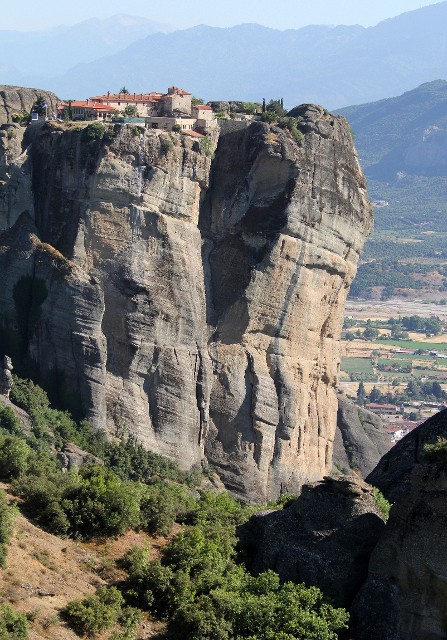
Since middle school, I've dreamt of seeing Meteora with my own eyes. We were not disappointed! It was spectacular!
And
it was on our drive to Meteora and Delphi that we discovered that we
were in fact on a mammal safari after all! Only this was not our
conventional safari - it was a ROAD KILL safari! We saw so many
European species splattered all over the pavement, that if we had
actually seen them alive, this would have been a very impressive mammal
trip indeed! Our journey from Delphi to Meteor took us across the
mountains via Route 48 to E65 north, and all the roadkill was spotted
along this route. We spotted European Badgers, Red Fox, Jackal, Stone
Martens, European Polecat, European Rabbit, Eastern European Hedgehog
and other unidentifiables! It really was impressive to see all of these
mammals - only it was very sad to see them all as pancakes. But at
least it was proof that the faunal diversity is still there in Greece.
(To
see images of the species we spotted, visit the species list below and
search the links attached. I decided these pics were a bit to graphic
to show on the general blog entry...)

The monasteries at Meteora - outstanding!
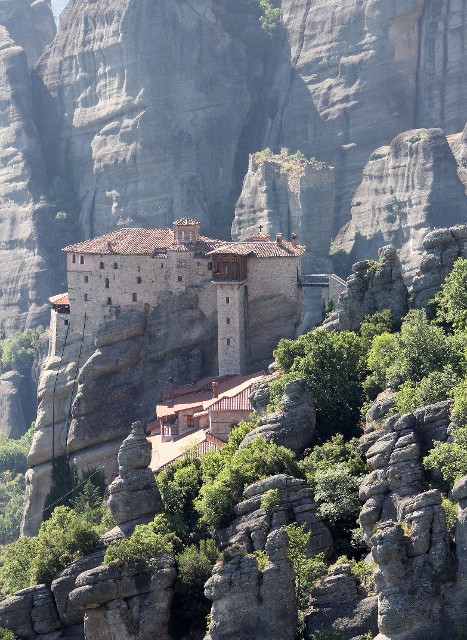
Meteora

We enjoyed our two days in the Meteora area exploring the amazing geologic and cultural phenomenon...

Meteora
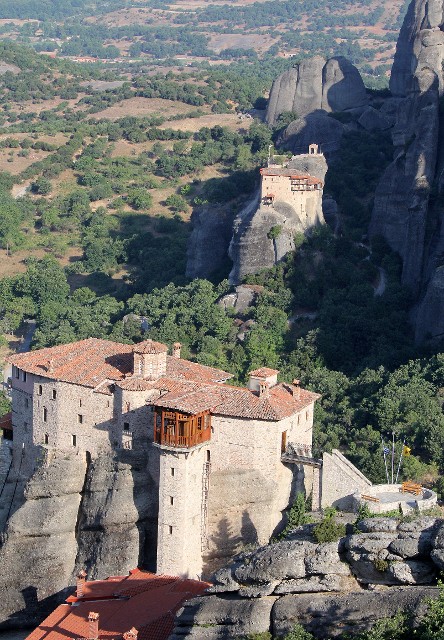
Every corner was a new and spectacular vista...

I remember back in middle school when I was doing the research in Meteora, the monks would need to climb rope ladders and bring their supplies up with pulleys and buckets. Now there are roads, stairs and access is for the masses.
Crete

Amazing Samaria Gorge National Park Crete, home of the "Kri Kri"!
Although we were saving the real mammal search for Crete, we'd already racked up nearly ten species! But Crete really was our main destination. We were hoping to spot the not-so-hard-to-see Cretan Wild Goat. We centered our search in Samaria Gorge, where there are many friendly goats roaming the ravines and dry river beds of the canyon. At least this is what we read before coming to Crete!
When we arrived in Crete and eventually made it to Sougia, one of the small seaside villages near the Canyon. Most trips to Samaria Gorge NP start and end in Chamia, a couple hours to the north of the actual canyon, where people jump on large busses and make their way to the top of the gorge, trek the 17 kilometers of the canyon and meet the same busses to take them back at night. We decided to make it a three day trip and enjoy the area a bit more. We were very glad we did! Sougia is spectacular and the Samaria Canyon is absolutely stunning.
Purported to be Europe's largest canyon - it's Grand Canyon - Samaria is an amazing trek. All downhill and all on cobble, it was one of our most painful treks ever. At 17 kms, it seems to go on forever! Thankfully it is spectacular for every inch. The vegetation transitions and the sheer nature and scenery make the trek itself very worthwhile. But for us, it was the goats that brought us to the area.
When
we checked in to the Syia Hotel (website here), an absolutely
spectacular place to spend several nights....or weeks....., we were
greeted by Markos Vittorakis who, upon learning that we were searching
for the wild goats, or locally known as Kri Kri, was a bit concerned
we'd be disappointed. He knew they were not guaranteed and was trying
ever so delicately to lower our expectations. We of course were fully
aware of how fickle wildlife sightings can be, so we assured him that
the trek itself would be more than enough to satisfy us! But Markos is a
great host - definitely goes the extra miles for his guests. I highly
recommend staying at his lodge.

Syia Hotel in Sougia, a great place to spend a week or two!
The
Samaria Gorge trek is about 17 kilometers, 13 or so of which are in the
actual Samaria Gorge National Park. The trek is all downhill - in
some cases very steep. The length of the trek is not bad at all really,
but the terrain is challenging - mostly cobble and rocks of various
sizes. The constant descent on the odd-shaped stones for so many hours
is a killer for sure. Normally a 10-mile hike doesn't hurt so bad but
we ached for almost a week after this one!
But
the scenery is spectacular. The trek starts at the top of the gorge at
1250 meters. You are deep in the mixed conifer forest at this
stage dominated by Calabrian Pine (Pinus brutia) and Mediterranean Cypress (Cupressus sempervirens)
trees are the dominant vegetation here. There are ample cliff faces to
scour looking for the Cretan Wild Goats, and they are often found there
so we hear....just not by us this day.

Samaria!

Our decent in to the Samaria Canyon took us through multiple plant communities. In this image we are in the mixed conifer community with Calabrian Pine (Pinus brutia) and Mediterranean Cypress (Cupressus sempervirens).

Calabrian Pine (Pinus brutia)

Calabrian Pine (Pinus brutia)

Great example of a European mixed conifer forest. We loved our trek through this spectacular community.

Cokie getting to know a grand-daddy Mediterranean Cypress (Cupressus sempervirens). I can only imagine how old this tree is...

There were hardwood species as well including the Cretan Maple (Acer sempervirens)

Stunning place...
The way the trek works is fairly complicated. You first must somehow get yourself to the trailhead at the summit of the gorge. To do this we enlisted the aid of Markos, our host at Syia Lodge who drove us up in our rental car. The 40-minute drive is nice and there are very limited ways to get to the trail head. If you stay in Chamia, you will need jump on one of the mega busses that drop tourists there. There are two taxis in Sougia that can also shuttle you up. I have no idea what they cost as they were full by the time we got there and this is why Markos helped us out.
Once you are done with the trek, you end up in Agia Roumeli village, a nice Lybian Sea-side village that is connected to civilization by the one or two ferries that come by daily. You will need to finish your trek by 5 or 5:30, depending on what direction you need to go. Our Sougia ferry left at 5PM and we were so damn slow on our trek that we were actually challenged to make it on time, even though we started the trek by 7AM! We did stop and photograph a heck of a lot though....
Our goal of course was the Cretan Wild Goats, or more properly known as "Kri Kri". While they are an actual wild species for sure, science has conclusively shown now that they are in fact a wild form of a previously domesticated variety that escaped in to the wild from the ancient Minoan people who migrated to Crete some 4000 years ago but is representative of perhaps the world's first domesticated goat dating some 10,000 years back. Now they are wild in some of the more remote and inaccessible spots on Crete and a few other locations in the Middle East. But so far as I can tell, the Cretan subspecies is fairly unique.
We were told that they would be viewable at Samaria Village, and they were very easy to see there, as they are habituated to the tourists giving handouts. But of course my goal was to photograph them in more wild conditions and that is a bit more challenging. Their habitat is fairly forested so it is easy to miss them and I suspect we missed three times as many as we spotted. But we did spot well over a dozen at several of the springs along the trail where evidently the goats come to water between spurts of tourists.
Kri Kri or Cretan Wild Goat (Capra aegagrus creticus)

A female and her kid working their way up the slope in Samaria, Crete.

Although we were prepared to be skunked, we did see well over a dozen Kri Kri this day.

Kri Kri

A Kri Kri graizing in Samaria

Kri Kri and kid!

Hello!

This one lost his mom....

Cretan Wild Goat

Our first Kri Kri hiding in the shrubs of Samaria. Of course Som spotted her first...
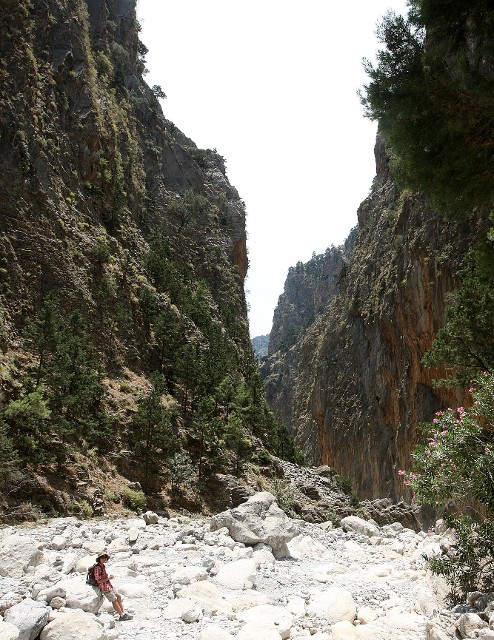
My own little Kri Kri taking a break in Samaria Gorge...An amazing trek.

Somie in Samaria Gorge! This trail made us ache so bad...
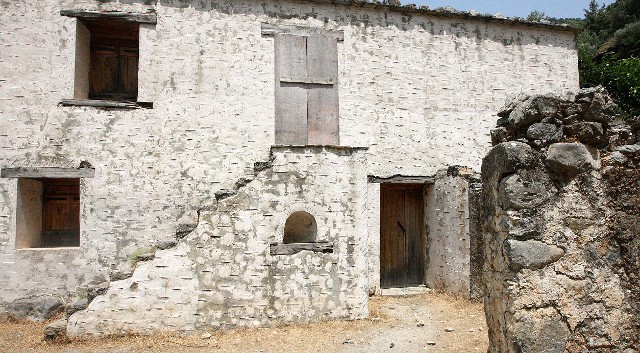
Samaria Village. This spectacular abandoned village is about half-way through the 17 km trek.

Samaria Village

Samaria Gorge
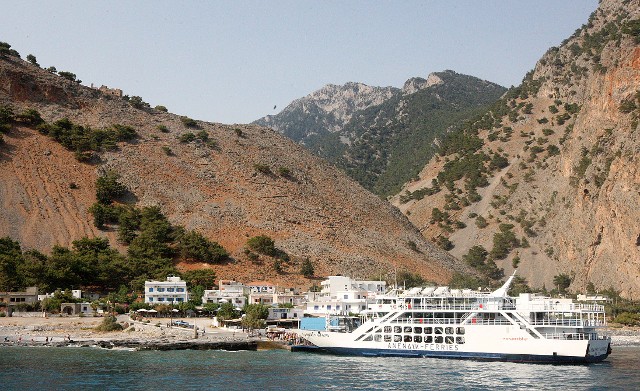
Agia Roumeli awaits the trekkers at the end of Samaria Gorge. Be sure to get there before 5PM or you will miss the ferry out!

The cruise back to Sougia takes us through some of the most spectacular unspoiled Cretan coastline.
While in Samaria Gorge we were limited to sightings of females and kids. Evidently the males wait until the end of the tourist day according to one of the rangers we spoke to at Samaria Village. They are a bit shier and tend to hang back in the woods or higher on the slopes and wait for the hoards of tourists to leave before coming in to water. We were very fortunate however to find that there was a captive male in Sougia at "Captain Georges" hotel, located adjacent to Syia Hotel. Captain George evidently caught "Romeo" when he was a very young kid and raised him and is now over 15-years old. (Here is Captain George's Contact)
Romeo the Kri Kri

Romeo the Cretan Wild Goat. Romeo is actually a very famous Kri Kri. He's appeared in numerous Greek movies and TV shows. Captain George raised him from the time he was a kid and he has traveled all over the world!

Romeo and Captain George roughhousing.
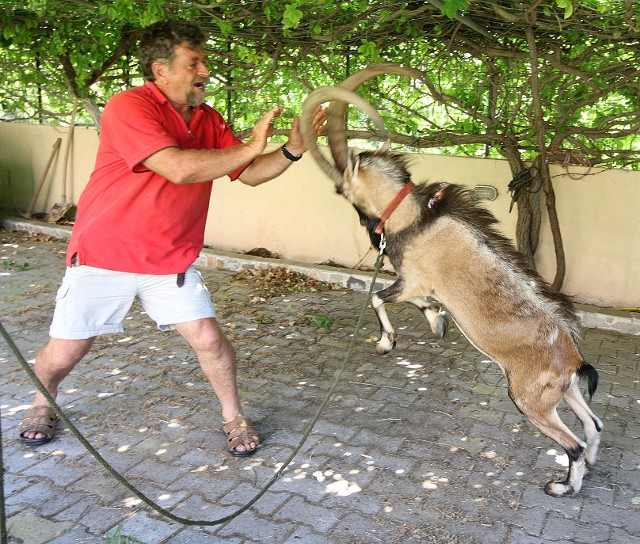
Romeo was much stronger than he might appear...

If Romeo hit you wrong, ouch!

Cokie using all of his strength against Romeo the Cretan Wild Goat!

This goat wanted to take Cokie down!

Both of these two were have a great time together!

Romeo was spectacular.
Romeo gave us a great opportunity to observe the appearance of an adult male. Some literature calls this goat the "Cretan Ibex", and it is easy to see why. The large curved horns and the black patterns and large beard are all very indicative of the male ibexes we've seen. But the size of the Cretan Ibex is literally about half of the size of the mainland species. I suppose this is all part of the island dwarfism we noted in other species we saw in Crete. (Sadly all of the other species we spotted, such as the very small Cretan Badgers, were once again all roadkill....)
Sougia and Crete are without a doubt locations we'd love to return to someday. The island is rich in history and beauty. The few days we spent exploring one of the wilder areas of the island made us wish we had scheduled more time there to explore some of the interior which is surprisingly immense and mountainous! Our two weeks in Greece in general was very nice. While our species list was short (two species! ...not counting the ten or so species we spotted as pancakes on the road) we experienced a tremendous amount and explored a country I had wanted to visit since I was a boy about my son's age!

I hope this little dude is enjoying his younger years... I sure am!
Greece Mammal List
- Kri Kri or Cretan Wild Goat (Capra aegagrus creticus)
- Greater Horseshoe Bat (Rhinolophus ferrumequinum)
- Feral Goat (Capra aegagrus hircus)
Greece Roadkill Mammal List
- European Red Fox (Vulpes vulpes crucigera) (Picture Here)
- Eastern Hedgehog (Erinaceus roumanicus) (Picture Here)
- Golden Jackel (Canus aureus)
- Weasel (Mustela nivalis)
- European Polecat (Mustela putorious) (Picture Here)
- Stone Marten (Martes foina) (Picture Here)
- Badger (Meles meles meles) (Picture Here)
- Cretan Badger (Meles meles arcalus) (Picture Here)
- Cretan Wildcat (Felis sylvestris cretensis) (Picture Here)
- European Wildcat (Felis sylvestris sylvestris)
- European Hare (Lepus europeaus)
- Countless little brown furry pancakes once representing shrews or rodents....
Other Stuff

Great Tits were very common in Samaria Gorge.

Hooded Crows in Meteora

Honey Buzzard (?) over Samaria Gorge...

Swallow-tail Butterfly in Athens
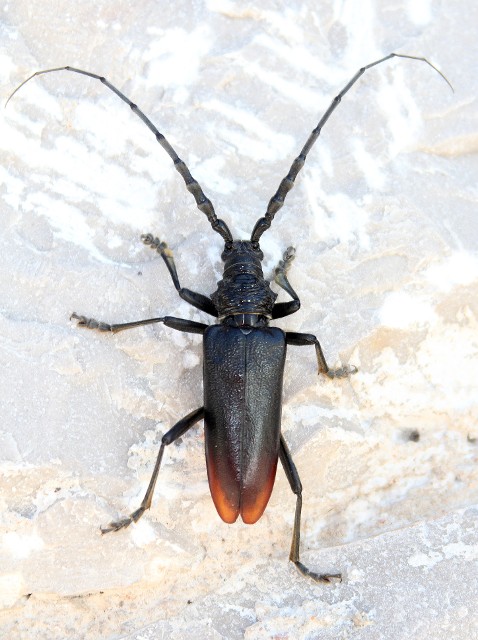
On the way to Meteora, I spotted this spectacular Cerambyx cerdo on the pavement. Great to finally see a live one in the wild!

There are feral goats in Samaria as well...

Cretan Skink in Samaria

Our spectacular moonrise at Heraklion, Crete. What a wonderful night.

I love my life with my family. I would not change a thing.
Be sure to check out our Greece Pbase galleries!
